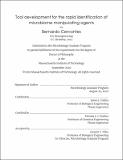| dc.contributor.advisor | James J. Collins and Kristala L. J. Prather. | en_US |
| dc.contributor.author | Cervantes, Bernardo. | en_US |
| dc.contributor.other | Massachusetts Institute of Technology. Department of Biology. | en_US |
| dc.date.accessioned | 2021-01-06T19:33:31Z | |
| dc.date.available | 2021-01-06T19:33:31Z | |
| dc.date.copyright | 2020 | en_US |
| dc.date.issued | 2020 | en_US |
| dc.identifier.uri | https://hdl.handle.net/1721.1/129224 | |
| dc.description | Thesis: Ph. D., Massachusetts Institute of Technology, Department of Biology, 2020 | en_US |
| dc.description | Cataloged from student-submitted PDF of thesis. | en_US |
| dc.description | Includes bibliographical references (pages 93-103). | en_US |
| dc.description.abstract | Manipulation of complex microbial communities, such as human microbiomes, plays a critical role in the study and treatment of microbiome associated diseases. However, the tools available to perform microbiome manipulations suffer from a lack of specificity. Current methods like the use of antibiotics and microbiome transplants decimate natural ecologies and run the risk of introducing unknown agents into the microbiome. New tools capable of manipulating the microbiome with strain level specificity hold great potential to advance research into the microbiome and the development of new therapeutics. In this thesis, I present advancements aimed to accelerate the discovery and study of new microbiome manipulating agents. First, I present our work to develop a method for the rapid identification of displacer strains (RIDS). Displacer strains are capable of selectively replacing other strains within a complex microbial community without damage to the ecology. We showed that RIDS is cheaper and faster than current methods for the discovery of microbe-microbe interactions. Next, I present our work using RIDS to discover a potential displacer strain (BN6) isolated from a healthy human. We show that BN6 secretes a narrow spectrum antimicrobial against Enterococci, an important bacterial genus associated with nosocomial infections. We also demonstrate BN6's ability to displace Enterococcus faecium in liquid coculture motivating further work to validate BN6's status as a displacer strain. I also present a collaborative effort to build a synthetic microbiome that enables its host to consume an otherwise inaccessible carbon source. Finally, I discuss the current state of microbiome manipulation tools where I highlight some of the exciting recent advancements. | en_US |
| dc.description.statementofresponsibility | by Bernardo Cervantes. | en_US |
| dc.format.extent | 117 pages | en_US |
| dc.language.iso | eng | en_US |
| dc.publisher | Massachusetts Institute of Technology | en_US |
| dc.rights | MIT theses may be protected by copyright. Please reuse MIT thesis content according to the MIT Libraries Permissions Policy, which is available through the URL provided. | en_US |
| dc.rights.uri | http://dspace.mit.edu/handle/1721.1/7582 | en_US |
| dc.subject | Biology. | en_US |
| dc.title | Tool development for the rapid identification of microbiome manipulating agents | en_US |
| dc.type | Thesis | en_US |
| dc.description.degree | Ph. D. | en_US |
| dc.contributor.department | Massachusetts Institute of Technology. Department of Biology | en_US |
| dc.identifier.oclc | 1227507314 | en_US |
| dc.description.collection | Ph.D. Massachusetts Institute of Technology, Department of Biology | en_US |
| dspace.imported | 2021-01-06T19:33:30Z | en_US |
| mit.thesis.degree | Doctoral | en_US |
| mit.thesis.department | Bio | en_US |
